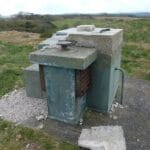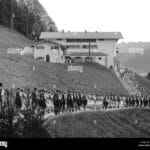The Bermuda Triangle: a place where ships and planes vanish without a trace. But what if a piece of World War II history holds a key to understanding this enduring mystery? Recent explorations suggest the possibility of secret German bunkers within the Triangle’s boundaries, opening up a fascinating—and somewhat spooky—chapter in this enduring enigma. This article delves into historical documents, analyzes sonar imagery, and examines expert opinions to explore this compelling theory, examining historical context and separating fact from fiction.
Bermuda Triangle German Bunkers: Unraveling a WWII Enigma
The Bermuda Triangle’s reputation for unexplained disappearances is well-established. But what if the answer lies not in supernatural forces, but in the hidden history of World War II? The possibility of German bunkers in this notorious region opens a new chapter in this enduring mystery.
WWII’s Shadow in the Devil’s Triangle
Could Nazi Germany have used the Bermuda Triangle for more than just a convenient hiding place for submarines? The idea, while chilling, isn’t entirely new. Hints and whispers for years suggest the existence of hidden German installations within the Triangle. Were these mere rumors, or do they point towards a deeper, more sinister secret?
Some believe these structures may have served as hidden submarine bases, providing vital resupply for U-boats. Others speculate about their use as secret storage locations for essential supplies or, perhaps even more intriguingly, as clandestine research facilities. The very notion raises more questions than answers. Could these hidden bases hold the key to some unexplained disappearances within the Triangle? This is a question researchers continue to explore.
The Nazi Navy’s Risky Atlantic Gamble
To assess the plausibility of hidden Bermuda Triangle bunkers, we must consider the broader context of WWII naval warfare in the Atlantic. German U-boats wreaked havoc on Allied shipping, causing widespread disruption and fear. While the ocean’s vastness provided a significant advantage, maintaining supply lines and finding safe bases presented a major challenge. The remote and unpredictable Bermuda Triangle, while treacherous, might have seemed like an appealing—albeit incredibly risky—location for a hidden base.
However, building and maintaining secret bases in such a harsh environment would have been extraordinarily difficult. Transporting materials, constructing structures capable of withstanding the area’s storms, and avoiding detection by Allied forces would have been a monumental undertaking, requiring immense engineering skill and unwavering secrecy. While the Nazis were masters of clandestine operations, successfully pulling off such a feat in the Bermuda Triangle seems unlikely given the challenges.
Documentary Evidence: A Critical Examination
Several documentaries have tackled this theory, presenting compelling images and eyewitness testimonies. While visually striking, it is crucial to approach such evidence with a critical eye. How reliable are the sources? Have alternative explanations—beyond the Nazi bunker theory—been fully considered? Can the purported discoveries be definitively linked to Nazi activity, or could they have other origins? These are questions that require careful consideration before drawing conclusions.
Analyzing the Evidence: A Scientific Approach
The lack of definitive proof remains a major obstacle. While anecdotal accounts and unexplained sonar anomalies are intriguing, they do not provide conclusive evidence. A robust scientific approach is crucial, avoiding dramatic conclusions based solely on speculation. The available evidence must be meticulously examined, and its reliability carefully weighed against competing hypotheses.
It’s equally important to acknowledge other possible factors that could explain disappearances in the Bermuda Triangle. Severe storms, navigational errors, and mechanical failures are all plausible explanations that should not be dismissed. It’s easy to be captivated by exciting theories, but adhering to the facts and considering all possibilities is paramount. The official stances of organizations like the US Coast Guard and NOAA (National Oceanic and Atmospheric Administration) should also be considered.
Exploring Further: The Path Ahead
Fortunately, new technologies, such as advanced sonar imaging and remotely operated underwater vehicles (ROVs), are opening up unprecedented opportunities to explore the ocean depths. These advancements offer the potential to uncover discoveries previously impossible. The exploration of this region requires collaboration; historians, archaeologists, and marine scientists must work together, combining their expertise to interpret the available evidence.
The search for evidence of German bunkers in the Bermuda Triangle is ongoing. It requires careful analysis, rigorous scientific standards, and a commitment to seeking the truth, regardless of the challenges. The mystery remains; but with dedication and careful exploration, we may uncover a significant part of this intriguing chapter of history.
Unanswered Questions and the Enduring Mystery
The discovery, or lack thereof, of these potential bunkers would fundamentally alter our understanding of WWII naval history. Were these structures more than figments of the imagination? The answer lies in continued investigation. The Bermuda Triangle closely guards its secrets, but with perseverance and dedicated exploration, we might finally unveil this intriguing—and potentially chilling—piece of history.
What is a German Bunker?
Let’s clarify the term “German bunker,” as its meaning extends beyond the sensationalized imagery often presented. These structures represent a wide range of fortifications built during WWII, varying significantly in size, complexity, and intended purpose.
Diving Deep into German Bunker Types: From Simple to Secret
What exactly constitutes a “German bunker”? It’s not a single entity, but a spectrum of fortifications. At one end, we find hastily constructed shelters—simple foxholes, shallow trenches, or small pillboxes made from readily available materials. These served as temporary defenses, thrown up quickly in times of urgent need. At the other end of the spectrum lie massive, intricate underground structures. These could be immense, permanent fortifications constructed of concrete and steel, designed to house coastal artillery or serve as command centers. Some were highly specialized, such as submarine pens, V-weapon launch sites, or even hidden factories. Each bunker type was meticulously designed and built for a specific military purpose.
Here’s a summary highlighting the diversity of German bunker types:
| Bunker Type | Description | Materials Used | Purpose |
|---|---|---|---|
| Field Fortifications | Small, temporary shelters (think foxholes, trenches, or basic pillboxes) | Wood, earth, sandbags | Quick defense, temporary cover |
| Permanent Fortifications | Large, durable structures (like coastal batteries or command bunkers) | Concrete, steel, reinforced earth | Long-term defense, command, control, storage |
| Specialized Structures | Unique structures with specific purposes (submarine pens, V-weapon launch sites, etc.) | Varied, often highly specialized materials | Specialized military operations |
| Underground Complexes | Extensive subterranean structures, sometimes incorporating multiple bunker types above. | Concrete, steel, reinforced rock, specialised shielding | Long-term operations, strategic command, secure storage |
Constructing a Concrete Colossus: The Building Process
Constructing these bunkers was a massive undertaking, often completed under pressure and challenging conditions. The sheer volume of materials required – tons of concrete, steel reinforcement – was immense. German engineers employed innovative techniques, utilizing prefabricated parts where feasible and adapting their methods to local conditions. Building in rocky terrain differed significantly from construction near coastlines. These weren’t simply dug holes; they were intricate subterranean fortresses.
Strategy and Location: Military Considerations
The placement of these bunkers was far from random; military strategy dictated their locations. Along the Atlantic Wall, for example, bunkers were essential for defense against an Allied invasion. Others served as nerve centers for directing military actions, while still others—such as V-weapon sites—were crucial for Germany’s offensive capabilities. Their placement reflects Germany’s military strategies and the realities of wartime conditions.
The Bermuda Triangle Enigma: Fact or Fiction?
Now, let’s address the claims of German bunkers within the Bermuda Triangle. While captivating, the evidence supporting these claims is weak. Logistically, building and supplying such installations so far from home in such a remote and harsh environment during WWII was likely impossible. Many claims are based on unverifiable stories and speculation. Numerous other plausible explanations exist for the region’s mysterious disappearances. Severe weather and navigational problems are far more probable.
What Happened After the War? The Legacy of the Bunkers
After WWII, the fate of these bunkers varied. Some were demolished, others abandoned, and some repurposed. Their sheer number presented a significant challenge to post-war authorities. Some bunkers have become museums or historical sites, while others remain decaying relics of the past; many have been lost to neglect or deliberate destruction. Their preservation is crucial for understanding this pivotal period in history.
Key Points to Remember:
- The term “German bunker” encompasses structures ranging from small, temporary shelters to massive underground complexes.
- Bunker design and construction evolved throughout WWII, adapting to new needs and technologies.
- Claims of German bunkers in the Bermuda Triangle lack solid evidence; alternative explanations are more likely.
- Studying German bunkers illuminates Nazi Germany’s military strategies and engineering capabilities. Research continues, and our understanding may evolve.
Much remains unknown about many of these bunkers. Ongoing research continues to provide new information, and our understanding of their construction, purpose, and fate is constantly evolving.
What is the Bermuda Triangle Mystery?
The Bermuda Triangle represents a fascinating blend of fact, fiction, and ongoing research. Let’s explore the enduring enigma of this region, where tall tales and real-life disappearances entwine.
The Devil’s Playground: A Sea of Secrets
Precisely defining the Bermuda Triangle’s boundaries is difficult. Most envision a triangle connecting Miami, Bermuda, and San Juan, Puerto Rico, but the lines remain blurred. What’s undeniable is the region’s challenging weather conditions—violent storms, unpredictable currents, and generally rough seas—making it a hazardous area for maritime activities.
Vanished Vessels and Missing Planes: Famous Cases and Unanswered Questions
The stories are legendary, including the disappearance of Flight 19 in 1945. Experienced pilots, lost without a trace in seemingly clear skies, and the subsequent disappearance of the rescue plane added another layer to the mystery. Are these disappearances truly anomalous, or are there mundane explanations?
Other accounts describe ships vanishing without a trace, leaving only speculation. Some incidents are well-documented; others exist as seafaring legends.
Unraveling the Truth: Science vs. Speculation
Numerous theories exist, ranging from the outlandish (alien abduction, supernatural forces) to the more plausible. Intense magnetic fields, underwater methane eruptions, and the unpredictable forces of nature are all suggested explanations. Human error—navigation mistakes, equipment malfunctions, poor decisions—must also be considered. Rogue waves, sudden, colossal walls of water, are another potential factor leading to maritime disasters.
Beyond the Headlines: Numbers Don’t Always Tell the Whole Story
Is the frequency of disappearances in the Bermuda Triangle truly exceptional? Statistical analysis suggests that the number of incidents isn’t unusually high compared to other heavily trafficked shipping lanes. Many disappearances likely have mundane explanations—severe weather or navigation errors.
Why the Enduring Fascination?
The Bermuda Triangle’s enduring appeal stems from our fascination with the unknown and mysteries that resist simple answers. The name itself evokes an air of mystique, and sensationalized stories have cemented its fearsome reputation.
The German Bunker Enigma: A Hidden History?
Let’s consider the alleged presence of German bunkers within the Bermuda Triangle. The notion of hidden U-boat bases, buried WWII secrets, and a potential link to disappearances is compelling. However, the credible evidence is minimal. More research is required to draw any firm conclusions. Evidence suggests the Nazis had operations in this region, but any remaining hidden bunkers still needs further investigation.
Advanced Technology and Future Discoveries
Modern technology offers new tools for investigating this mystery. Sonar technology, autonomous underwater vehicles (AUVs), and improved mapping techniques enable more detailed exploration of the ocean floor. Combining this with historical research and collaboration among experts promises future breakthroughs.
What We Know (and Don’t Know)
In summary:
- The Bermuda Triangle’s reputation stems from challenging weather and currents.
- Human error and severe weather are likely to blame for many disappearances.
- Statistical analysis indicates the number of incidents is not unusually high.
- The enduring fascination likely results from human curiosity about the unexplained.
- The hypothetical existence of German bunkers requires further evidence.
The Bermuda Triangle mystery is a blend of fact, fiction, and ongoing research. While some mysteries may be solved, others may remain forever shrouded, fueling speculation and imagination. The search for answers continues.
What Happens in the German Bunker in 1917?
Let’s explore the pivotal German bunker scene in Sam Mendes’s film 1917, clarifying its historical context and dispelling any misinformation linking it to the Bermuda Triangle.
The scene’s power lies in its depiction of the brutal realities of trench warfare and the ever-present threat of death faced by soldiers in WWI. This scene, a meticulously crafted representation of a WWI battlefield hazard, holds no connection whatsoever to the Bermuda Triangle.
The booby-trapped bunker vividly portrays the ingenuity of battlefield engineering and the devastating consequences for soldiers caught in its path. The near-miss experienced by Schofield and Blake showcases the film’s key themes: survival, sacrifice, and the psychological toll of war.
The historical accuracy of this scene should be discussed. While 1917 is not a documentary, it’s constructed to realistically depict the conditions soldiers encountered. The use of booby traps was common in WWI, but the specifics of the film’s depiction may be a dramatization for greater narrative effect.
The scene’s impact on the film’s narrative is significant. The near-death experience affects the characters, driving their mission forward and reinforcing the film’s underlying themes. Blake’s fate after the encounter underscores war’s brutal realities.
The directorial choices impacting the scene, including cinematography, sound design, and camera angles, meticulously build suspense and highlight the scene’s danger.
In short, the German bunker scene in 1917 is a key moment, emphasizing the harsh realities of WWI. This powerful representation of warfare, however, is unrelated to the Bermuda Triangle. Any claims to the contrary should be scrutinized.
- Unveiling Bernhard Caesar Einstein’s Scientific Achievements: A Legacy in Engineering - July 15, 2025
- Uncover who is Jerry McSorley: CEO, Family Man, Business Success Story - July 15, 2025
- Discover Bernhard Caesar Einstein’s Scientific Contributions: Unveiling a Legacy Beyond Einstein - July 15, 2025














